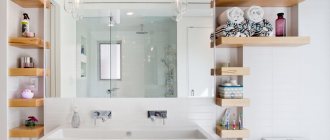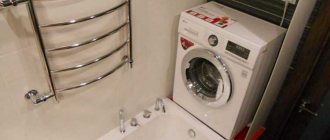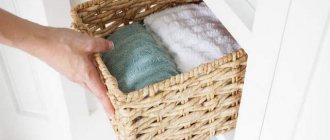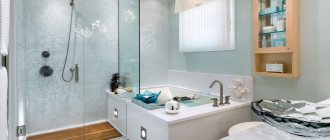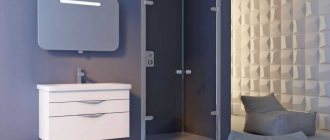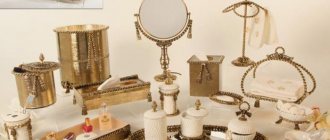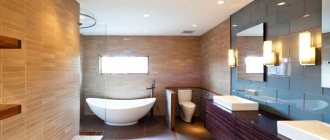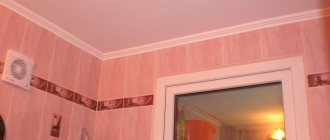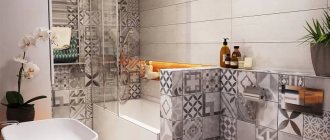How do mold spores appear?
Mold has lived on earth for millions of years, its mycelia are found wherever there is dampness, little sunlight and no air movement. Tiny fungal spores are in the air, and they can settle anywhere, as long as favorable conditions are created for them. Humidity is more than 90%, air temperature is above +20 degrees and mycelium colonies begin to grow at lightning speed. You can notice the appearance of mold in the dark corners of the garden, in the cellar, basement; it happily settles in the kitchen near the sink, in cellophane-packed products.
The bathroom is the perfect place for fungus to grow. The humidity level in the bathroom is the highest in the entire apartment. After taking a shower, bath, or hand washing, water droplets dry for a long time, condensation forms on all surfaces, thereby creating easy places for mold mycelium to multiply. Why does mold occur in the bathroom, and what to do to prevent its growth?
Ventilation in the bathroom is the best remedy for mold
Black mold also appears in poorly ventilated areas. In bathrooms, simple conventional ventilation is not enough. A poorly functioning hood in a damp room can also cause fungus.
It has been noticed that in bathrooms that have a window, mold occurs less frequently. The sun's rays penetrating into the room kill mold spores, which are destroyed by UV rays. You may notice that where there is not enough sunlight, namely corners, damp places under the bathtub, behind the sink, black, gray and yellow-green plaque appears.
Traditional methods for fighting fungus
Those who are wary of “chemistry” and do not want to spend money on it should try to kill pathogenic fungus on the walls in the bathroom and other places using traditional methods.
Tea tree oil is strong against barely emerging mold. 2 tsp. it will need to be poured into 0.5 liters of water. The resulting solution is sprayed from a spray bottle onto the surface. You will have to wait until it dries and not use the bath for half a day, since the product is not washed off. An additional bonus from its use is air deodorization.
Copper sulfate (blue anti-fungal powder) does the job perfectly. The solution is prepared from 1 liter of water and 10 g of vitriol. The mixture is applied with a brush and gloves on your hands.
Baking soda and vinegar are easy to use. It is enough to sprinkle (water) one of these products on the affected areas. These substances begin their work with a warning hiss. Once the reaction is complete, they should be washed off with soapy water. The disadvantage of this method is that it can only be used on horizontal surfaces.
Boric acid destroys fungus when mixed with vinegar, which also includes hydrogen peroxide and water. The mix is made in the proportion 1:2:2:4. The affected areas are wiped with it.
Potassium permanganate is effective in cases of barely emerging mold. This is done with a sponge moistened in a solution of potassium permanganate with warm water. Ingredient ratio: 1 tsp. powder and 1 liter of liquid. The composition does not need to be washed off after treatment.
“Domestos” and “Belizna” clean ergot-infested areas. A concentrated solution with these chlorine-containing agents and water is made in a 1:1 ratio. After treating moldy areas, it is washed off with plenty of water. For work you need protective equipment.
Borax removes fungus in tandem with water. 200 g of borax should be dissolved in 2.5 liters of water, take 1 glass of borax. The composition applied to the ergot should be wiped off with paper after a while.
All products also act as disinfection of the room after methods of eliminating the fungus.
Mold and our health
Mold happily settles in our bathroom, under tiles, in tile joints, paint, under plastic, on cement surfaces, causing harm to health day after day. A “harmless” neighborhood turns into a big health problem over time. During breathing, spores easily enter the lungs, are absorbed by the blood and spread to all organs. Over time, you may notice dizziness, loss of strength, breathing problems, in particular asthmatic attacks.
Mold in the bathroom - health problems
Studies have shown that mold can cause cancer. Black mold is especially dangerous for children, the elderly, and weakened people.
Important. You can undergo treatment for a long time, but until the cause of the ailment, namely dampness and mold, is eliminated, there will be no positive result.
How to prevent mold
Mold has appeared on the walls, how to fight it? The best way to combat mold is prevention. Of course, if there is no window in the bathroom through which sunlight can penetrate, it is not always possible to do so, especially when you live in a standard apartment. But preventing high humidity is quite possible.
How to get rid of condensation on a pipe
Condensation on pipes - treated with Merylon
The first thing you need to examine is the cold water pipes and the supply to the toilet.
Important. It is also necessary to check the pipes for excess condensation. If there is condensation (sweating pipe), it is better to wrap it with Merylon, this will greatly improve the situation
Checking pipes for leaks (snotty)
And so, first, we check all pipes and connections for water leaks. Perhaps a microscopic crack has appeared, or a connection through which water is leaking has weakened, and mold may appear here.
When renovating a bathroom, we try to close all pipes and communications whenever possible. From an aesthetic point of view, this is completely justified, but by hiding everything behind the panels under the bathtub, behind the sink, behind the washing machine, we may not notice a water leak during the process.
And only when a puddle appears, dampness is felt, mold becomes noticeable, we begin to do something. It is necessary to check the condition of the pipes and the reliability of the connections from time to time. All plumbing connections must be dry.
We eliminate leaks in pipes
Setting up ventilation
Secondly, it is necessary to establish good ventilation. When repairs are being made, it is worth checking the condition of the stationary hood to see how well it works. It is a good idea to install an additional ventilation system. It could be an electric fan. Longitudinal or circular holes made at the bottom of the bathroom door will improve air circulation. It is also recommended to periodically open the doors for ventilation. This is especially recommended after taking a shower. It is better to dry wet towels on heated towel rails. In summer, when there is no heating, you can install an electric heated towel rail. And, of course, never dry things in the bathroom.
What to do to prevent humidity from rising in the bathroom?
Before removing fungus from the bathroom, take care to create conditions that would exclude the possibility of their reappearance. Since it is impossible to change the air temperature in this room, then try to do everything possible and impossible to reduce the humidity.
First, check the room for leaks or places where moisture may accumulate. Often, small cracks in pipes can cause the appearance of small, non-drying puddles that are not noticeable, for example, located under the bathtub or in the corner behind the washing machine, where they are not visible at all.
If you find leaks, fix them immediately. This will be the first step to reduce the humidity in the bathroom.
After this, make sure the bathroom is properly ventilated. It is necessary to ensure that air circulates freely throughout the room - this is achieved by ventilation shafts provided during the construction of the building.
If natural ventilation is disrupted, it is necessary to install forced ventilation by installing special devices in the ventilation openings. In addition, do not turn the bathroom into a drying room - this leads to a guaranteed mold growth.
The necessary air circulation in the room can be achieved using the traditional method - by arranging exhaust ventilation and installing an additional fan in it.
And only the use of preventive measures will help protect walls, ceilings and furniture from the appearance of fungus and mold, and apartment residents from the appearance of diseases.
Mold prevention
Advice.
To prevent the appearance of mold, it is necessary to select appropriate materials that contain antiseptics during repair work. means against mold and mildew • Antifungal emulsion is added to adhesive and cement mixtures for masonry, plastering, painting walls, and grouting tiles.
The solution is also pre-applied to all surfaces. The emulsion is completely safe. • Izocid prevents the appearance of fungal spores, fights microalgae and other types of fungi. Added to plaster and water-soluble mixtures. • Emulsion “MIL KILL” based on latex, preventing the appearance of fungal flora. Penetrates well into porous surfaces, is non-toxic, can be used in any room with high humidity. • Antiseptic aqueous solution “DALI” is used for prevention and control of existing mold. Can be used in wood processing.
Causes of fungus
If you find mold on the walls in the bathroom, then in this case there is nothing left to do but to act in order to quickly deal with the fungus that has arisen . Otherwise, a little time will pass and the situation will become more complicated: you will have to eliminate the consequences of the activity of microorganisms that have settled on the walls.
Mold doesn't just appear that way. Its occurrence occurs due to certain reasons , the most common include the following:
- High humidity. The fungus appears only in rooms where a constant humid environment prevails. Optimal conditions for its development exist in the bathroom, since equipment related to the use of water is constantly used in this room. Every day a person takes a shower, and regularly uses the washing machine and sink. It is quite rare to find a bathroom in which dry air predominates. The situation with high humidity is aggravated if there is a faulty plumbing in the room or condensation forms on the water pipes.
- Lack of natural light. Direct sunlight is harmful to mold. Therefore, most often it appears in the bathroom. The peculiarity of this room is that it has no windows facing the street. Artificial lighting is not an obstacle to the appearance of mold on the walls. In country houses, the situation is similar, since the owners do not bother installing windows in the bathroom during construction.
- Warm. In order for the fungus to develop, it needs certain temperature conditions. The bathroom is most often a small room in which a heated towel rail is always installed. It provides a comfortable microclimate. Hot water, which is used quite often, also helps to increase the temperature.
- Presence of dark and hard-to-reach places. Microorganisms develop where there is no light and where cleaning is infrequent. As a rule, colonies form in hard-to-reach places, actively multiply, and then move to visible surfaces. Often fungal colonies appear on the seams of tiles. If detected, it is necessary to clean the seam and then treat it with a composition with a powerful antibacterial effect.
- Difficult air circulation. Another condition for the development of fungus is the lack of normal air circulation. If the natural ventilation system is ineffective, then after some time in a humid, warm room mold will appear on the walls.
We fight mold in different ways
How to remove mold in the bathroom, what modern and traditional methods can be used? When the first signs of mold appear, you should not waste time and wait until large areas are infected. Let's start the fight right away. Small areas can be treated using everything we have in our kitchen and medicine cabinet.
Vinegar is a tool that can be used to remove small colonies of spores. Acetic acid is safe and disappears quickly. Here's how to remove mold in your bathroom using vinegar:
1. clean the surface with a brush or scraper, if possible; 2. the product is applied to the affected areas of the surface either with a spray or with a swab or cloth;
How to remove mold - instructions
3. after drying, it is necessary to mechanically clean the area; 4. rinse with water; 5. treat with any antiseptic.
How to remove mold - instructions
Hydrogen peroxide is an excellent antibacterial agent. You can use a ready-made solution or dissolve tablets. White effervescent tablets dissolve easily in plain water. Peroxide can be used to clean any surface: plastic, tiles, wooden objects coated with paint, varnish. But we must remember that peroxide also bleaches, which is good for white surfaces, sealants, and grout, but white stains may remain on the furniture. Baking soda and regular bleach, both chlorine and active oxygen, can be excellent means at hand. An excellent remedy for mold in the bathroom is copper sulfate, which is used in gardening work.
How to get rid of it forever
If you want to get rid of mold in the bathroom forever, you will have to undertake a full renovation. It is necessary to remove all the finishing along with the plaster. Bare walls - concrete or brick - should be treated with a primer with antibacterial properties (there are some), when plastering, use a composition with antifungal additives or you can add it to a standard cement-sand mortar yourself. After the plaster has dried, use primer, then tiling using glue with antifungal additives. Even the grouting of joints must have appropriate properties.
The fungus is not only on the surface. His spores inside the wall
With this state of affairs and properly functioning ventilation, you will no longer have problems with mold and fungi. All other methods allow you to get rid of mold in the bathroom only for a certain period of time.
Below is a description of some of the products that can be used to combat mold and mildew during bathroom renovations. The same means can be used to treat already finished surfaces, but they are more effective at the stage of finishing work.
- Fongifluid Alpa (Alpa). It has a bluish-greenish tint, but does not change the color of the treated surfaces. Suitable for processing concrete, brick, plaster, gypsum boards, wood and its derivatives. Loose and porous surfaces must be cleaned; dense surfaces must be treated without preparation. Surfaces are washed with water, dried, then the product is applied. Recommended consumption is 1 liter per 4-5 square meters. m. Leave for 4-5 days. This drug is good at the repair stage - it improves adhesion. If finishing materials were processed, wipe the surface with a damp cloth.
- Homeenpoisto from Tikkurilla. Finnish product for wood, but can also be used for concrete and plastered surfaces before finishing.
Some products that can be used during repairs to get rid of fungus - BIOZID SANIERLOESUNG (Biocide). Suitable for processing most building materials. Apply by brush or roller only (do not spray). The surface is pre-cleaned (fungus and mold can be mechanically removed). The Biocide is applied to a dry surface in two layers. The break between treatments is 30 minutes. Leave the second layer for 24 hours. After treating areas affected by black mold, the color does not disappear, even though the fungus is destroyed. To discolor stains, it is necessary to additionally treat them with a chlorine-containing composition.
Now you know how to get rid of mold in the bathroom for a long time and even forever.
Removing mold from sealant
Here we have only two options: chemistry or replacing the sealant. The second option is, of course, more reliable and more correct; with this option, mold simply has no chance! To do this, you will need antibacterial plumbing sealant and the following tools:
Knife - scraper for removing old sealant and smoothing out new one
Using this tool, carefully and thoroughly remove the old sealant, then clean the surface of any old sealant residue and dirt. Then degrease the surface with white spirit and leave to dry. Apply new sealant and smooth it evenly using a plastic putty knife.
Remove old sealant and apply new one
Before cleaning up mold in the bathroom, it is worth taking care of safety, these are normal precautions. If you use acetic acid and a concentrated solution of peroxide, copper (iron) sulfate, chlorine-containing solutions and acids, it is recommended to wear gloves to avoid getting a chemical burn.
All of the above methods are suitable if the foci of infection are small and are in the initial stage, that is, small black dots have appeared. What to do when large lesions are discovered? Only strong remedies such as creosote will help here.
This is a fairly aggressive oily liquid based on tar, dissolving only with the addition of alcohol or ether. It is used to process concrete, brick, and tiles. After treatment, creosote must be removed with fat-soluble detergents. Robots are carried out in a well-ventilated area, wearing protective suits and masks.
Creosote - radical mold repellent
This article is devoted to how to prevent and remove mold in the bathroom. To sum it up, let's say that preventive measures with antiseptics, good ventilation, elimination of leaks and timely cleaning and cleanliness will prevent an unwanted neighbor from settling in your bathroom - mold.
Removing fungus from walls and ceilings
Specialized antifungal products are the best remedies for fungus in the bathroom. You can buy them at any building materials store and have one drawback - a high content of chemicals.
Therefore, when handling them, you must follow all the necessary instructions. These products are excellent at combating fungal growths on the walls and ceiling of the bathroom.
Antiseptic agents are different types of primer solutions that are applied immediately before plastering, painting or wallpapering. They destroy existing fungus well and serve as excellent protection against the appearance of new ones. Before using the product, thoroughly clean the surface from contaminated plaster to slabs or bricks and dry. Then treat the dry surface with an antiseptic using a brush and let it dry. After drying, you can begin repair work.
Read here: The smell of mold: TOP 20 ways to get rid of the smell of dampness and mold in the apartment
Various types of bleaches also do a good job of removing fungal growths. It is mainly used for cleaning mold from tiles, glass and other hard surfaces.
When working with bleach, exercise extreme caution; the room must be ventilated and work must be carried out with gloves and a respirator.
Dilute the solution with water in the proportions of 10 parts water and one part bleach. Then apply it with a brush to a previously dried area of the wall or ceiling and wait until it dries completely. The most common and effective products include Dali, Biotol spray and Fungicidal solution.

